
Turkish Journal of Intensive Care-Turk Yogun Bakim Dergisi
Scope & Guideline
Exploring New Frontiers in Intensive Care Medicine
Introduction
Aims and Scopes
- Clinical Outcomes in Critical Care:
The journal emphasizes research on clinical outcomes for critically ill patients, exploring various interventions and treatments that affect mortality and morbidity rates. - Innovative Practices in Intensive Care Nursing:
A significant focus is placed on the role of nursing in intensive care, including studies on nursing practices, psychological impacts on staff, and family involvement in patient care. - Emerging Infectious Diseases and ICU Management:
Research on the management of infectious diseases, particularly COVID-19, has been a core area, investigating treatment protocols and their effectiveness in the ICU setting. - Technological Advancements and Monitoring Techniques:
The journal covers advancements in monitoring technologies and their application in critical care, including studies on cardiac output measurements and the efficacy of various monitoring techniques. - Patient Safety and Quality Improvement:
There is a focus on patient safety initiatives and quality improvement measures in ICUs, including studies on infection control, medication management, and the prevention of pressure injuries. - Educational Aspects and Training in Intensive Care:
The journal also addresses educational strategies and training programs for healthcare professionals in intensive care, aiming to improve knowledge and skills among practitioners.
Trending and Emerging
- COVID-19 Related Research:
A significant increase in studies addressing the management, treatment, and outcomes of COVID-19 patients in intensive care settings has been observed, reflecting the pandemic's impact on critical care practices. - Psychosocial Aspects of ICU Care:
Emerging research on the psychological well-being of healthcare workers and the importance of family involvement in patient care during end-of-life situations indicates a growing recognition of the psychosocial dimensions of intensive care. - Use of Advanced Monitoring and Treatment Modalities:
There is a trend towards exploring new technologies and treatment modalities, such as extracorporeal membrane oxygenation (ECMO) and advanced respiratory support techniques, indicating an interest in cutting-edge ICU practices. - Antimicrobial Resistance and Infection Control:
Research on antimicrobial resistance, particularly within the context of ICU infections, is gaining prominence, emphasizing the need for effective infection control measures in critical care environments. - Rehabilitation and Recovery in Critical Care:
An increasing focus on rehabilitation strategies for patients post-intensive care, including studies on early mobilization and psychological support, highlights an emerging trend towards holistic patient recovery.
Declining or Waning
- Traditional Pharmacological Interventions:
Research focusing solely on traditional pharmacological treatments, such as specific drug comparisons, has seen a decline, possibly due to the shift towards holistic and multidisciplinary approaches in ICU management. - General Sepsis Research without Specific Context:
There has been a reduction in studies that broadly address sepsis without a specific context, such as investigations that do not integrate recent findings related to COVID-19 or antibiotic resistance. - Single-Center Studies with Limited Scope:
The prevalence of single-center studies that do not provide broader implications or multicenter perspectives is declining, as the journal increasingly favors studies with wider relevance and generalizability. - Classic Nutritional Management Studies:
Research focused on classic nutritional management protocols in intensive care has decreased, possibly due to the emergence of more innovative and individualized approaches to patient nutrition.
Similar Journals
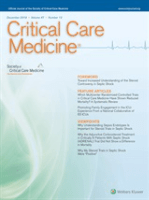
CRITICAL CARE MEDICINE
Advancing Critical Insights for Lifesaving CareCRITICAL CARE MEDICINE is a premier journal dedicated to the advancement of knowledge and practice in the field of critical care and intensive care medicine. Published by Lippincott Williams & Wilkins, this distinguished journal has been at the forefront of medical research since its inception in 1973, and it continues to offer insights into the latest developments and innovations in critical care. With a remarkable ranking of #5 out of 110 in Scopus' Critical Care category and a 95th percentile rating, CRITICAL CARE MEDICINE is a leading source for high-impact research, reviews, and clinical studies. The journal is recognized as a Q1 publication, underscoring its authoritative presence within the academic community. Researchers and clinicians are encouraged to engage with cutting-edge findings that aim to improve patient care and outcomes. Although the journal is not open access, it remains an essential resource for professionals seeking to enhance their understanding and application of critical care practices.

CRITICAL CARE CLINICS
Empowering Research to Enhance Patient OutcomesCRITICAL CARE CLINICS is a premier academic journal published by W B SAUNDERS CO-ELSEVIER INC, focusing on advancing knowledge in the fields of Critical Care and Intensive Care Medicine. With an impressive impact factor and designated as Q1 in both Critical Care and Intensive Medicine categories, this journal is a leading resource for healthcare professionals, researchers, and students alike. Since its establishment in 1985, it has evolved into an essential conduit for cutting-edge research, clinical insights, and evidence-based practices, bridging the gap between theoretical understanding and practical application in critical care. The journal maintains a high ranking, being positioned 15th of 110 in its category according to Scopus, with a noteworthy percentile of 86, indicating its influence and relevance in contemporary medical discourse. Although the journal is not open access, it provides valuable content for those dedicated to enhancing patient care and advancing the science of critical medicine. Its commitment to excellence makes it a vital resource for anyone engaged in the dynamic field of critical care.
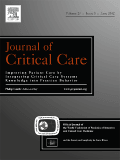
JOURNAL OF CRITICAL CARE
Transforming Critical Care Practices with Rigorous ResearchJOURNAL OF CRITICAL CARE, published by W B SAUNDERS CO-ELSEVIER INC, is a prestigious peer-reviewed journal in the field of critical care and intensive care medicine. With an impressive Q1 classification in 2023, it stands as a leading publication among its peers, ranking #12 out of 110 in the Scopus database, which places it in the 89th percentile of critical care-related journals. Established in 1986 and with a converged timeline extending to 2025, the journal serves as a critical resource for international researchers, healthcare professionals, and students dedicated to advancing practices and understanding within the realm of critical care. Although it does not offer Open Access, the journal provides high-quality, rigorously reviewed articles that address contemporary issues, innovative techniques, and groundbreaking research in critical care medicine. By fostering scholarly dialogue and disseminating new knowledge, the JOURNAL OF CRITICAL CARE is pivotal in shaping the future of intensive patient care and enhancing health outcomes.
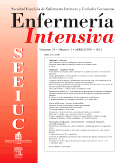
Enfermeria Intensiva
Enhancing Outcomes in Critical Care NursingEnfermeria Intensiva, published by Elsevier Science Inc, is a highly regarded journal in the fields of Advanced and Specialized Nursing as well as Critical Care and Intensive Care Medicine. With an impressive track record spanning from 1994 to 2024, this journal serves as a vital resource for researchers, healthcare professionals, and students dedicated to enhancing the quality of patient care in critical settings. It holds a coveted Q2 ranking in multiple nursing categories as of 2023, reflecting its influence and contribution to the ongoing discourse in nursing practices. Although currently not an open access journal, it continues to provide intricate insights into both fundamental skills and specialized techniques essential in intensive nursing care. By bridging research and practical application, Enfermeria Intensiva plays a pivotal role in advancing knowledge and improving outcomes in critical care environments.
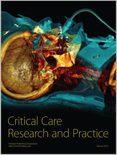
Critical Care Research and Practice
Transforming critical care through innovative research and practice.Critical Care Research and Practice is a distinguished open-access journal published by HINDAWI LTD that has been at the forefront of disseminating vital research in the fields of critical care and intensive care medicine since its inception in 2010. With an impressive Q2 ranking in its category and positioned in the top 63rd percentile according to Scopus rankings, the journal serves as a critical platform for researchers, practitioners, and students aiming to advance their understanding and improve outcomes in intensive care settings. Based in Egypt, the journal's breadth encompasses diverse aspects of critical care, including innovations in treatment protocols, evidence-based practices, and the latest advancements in patient care strategies. Through its commitment to open access, Critical Care Research and Practice ensures that high-quality research is readily available to a global audience, fostering collaboration and knowledge sharing across the medical community.

Signa Vitae
Fostering interdisciplinary dialogue for better patient outcomes.Signa Vitae is a distinguished academic journal published by MRE PRESS, focusing on critical care, intensive care medicine, and emergency medicine. Established in 2008 and running through 2024, this journal serves as an essential conduit for the dissemination of innovative research and clinical practices in these dynamic fields. Based in Croatia, Signa Vitae is indexed in Scopus, highlighting its importance within the scholarly community, boasting respectable quartiles with a Q3 ranking in both Critical Care and Intensive Care Medicine and Emergency Medicine as of 2023. Although it operates under a traditional access model, the journal aims to enhance knowledge sharing and interdisciplinary dialogue among researchers, healthcare professionals, and students globally, addressing the urgent challenges and advancements in patient care. By providing a platform for high-quality studies and reviews, Signa Vitae continues to advance the conversation and practice within critical and emergency medicine.
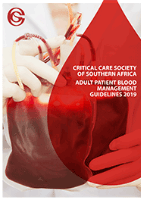
Southern African Journal of Critical Care
Empowering Southern Africa's critical care community through research.The Southern African Journal of Critical Care, published by the Health & Medical Publishing Group, serves as a pivotal platform for advancing knowledge and practice in the field of critical care and intensive care medicine. With an ISSN of 1562-8264 and an E-ISSN of 2078-676X, this Open Access journal has been making research accessible since 2004, enabling professionals and researchers to share vital findings that shape patient outcomes across Southern Africa and beyond. The journal is recognized in the Q2 category in the 2023 rankings of critical care and intensive care medicine, positioning it among the top-tier publications in the field. With its convergence spanning from 2001 to 2023, the journal continues to uphold rigorous standards and strives to disseminate impactful research as reflected by its Scopus rank of #65 out of 110 and a percentile of 41st. Researchers, clinicians, and students alike will find valuable insights and cutting-edge developments in this essential resource, fostering a community dedicated to improving outcomes in critical care.
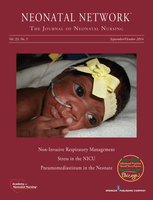
Neonatal Network
Transforming neonatal care through collaborative wisdom.Neonatal Network, published by Springer Publishing Co, is a respected journal in the field of Critical Care and Intensive Care Medicine, focusing on the complexities of neonatal health and development. With an ISSN of 0730-0832 and an E-ISSN of 1539-2880, this journal has been a vital resource for practitioners, researchers, and students since its inception in 1985. Covering a pivotal scope that encompasses Critical Care Nursing, Pediatrics, and Perinatology, it aims to enhance the understanding and treatment of newborns in critical conditions. Although categorized in the Q3 and Q4 quartiles by Scopus for 2023, its contributions remain significant, fostering a platform where innovative research and clinical wisdom converge for the benefit of neonatal care. As a non-open access journal, it provides insightful articles that are pivotal for enhancing neonatal practices and outcomes, ensuring its relevance as a distinguished academic outlet through 2024. The journal's rich history and focus on interdisciplinary collaboration make it an essential resource for those committed to advancing neonatal health.

ANASTHESIOLOGIE & INTENSIVMEDIZIN
Advancing Anesthesia and Intensive Care KnowledgeANASTHESIOLOGIE & INTENSIVMEDIZIN is a peer-reviewed journal dedicated to the fields of anesthesiology, critical care, and intensive medicine. Published by AKTIV DRUCK & VERLAG GMBH in Germany, this journal has been an essential resource in the medical community since its inception in 1978. With a current impact factor placing it in the Q3 quartile in both anesthesiology and critical care categories, it serves as a platform for disseminating cutting-edge research and innovative practices. The journal invites contributions that enhance the understanding of pain management, perioperative care, and intensive treatment methodologies. Although not open access, it remains committed to advancing knowledge and improving patient outcomes. With a strong focus on practical applications, ANASTHESIOLOGIE & INTENSIVMEDIZIN is invaluable for researchers, clinical practitioners, and students seeking to deepen their expertise in these crucial areas of healthcare.
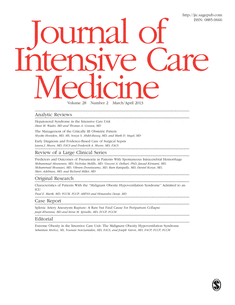
JOURNAL OF INTENSIVE CARE MEDICINE
Navigating the Complexities of Intensive Care TogetherJOURNAL OF INTENSIVE CARE MEDICINE, published by SAGE PUBLICATIONS INC, is a leading peer-reviewed journal dedicated to advancing the field of critical care and intensive medicine. With an ISSN of 0885-0666 and an E-ISSN of 1525-1489, this esteemed journal showcases innovative research, clinical practices, and synthesis of knowledge that informs the complexities of patient care in intensive settings. Recognized for its exceptional impact, it holds a prestigious Q1 ranking in the Critical Care and Intensive Care Medicine category, landing in the upper 15% of its field according to Scopus rankings. Celebrating over three decades of publication since its inception in 1986, the journal serves both as a resource for seasoned professionals and a platform for emerging researchers eager to contribute to evidence-based practice. Although not open access, the journal ensures that critical insights and advancements are accessible to a broad audience, fostering a collaborative environment that is essential for the evolution of intensive care protocols and the enhancement of patient outcomes. With its commitment to excellence, the JOURNAL OF INTENSIVE CARE MEDICINE stands out as an invaluable resource that continues to shape the future of healthcare in critical domains.